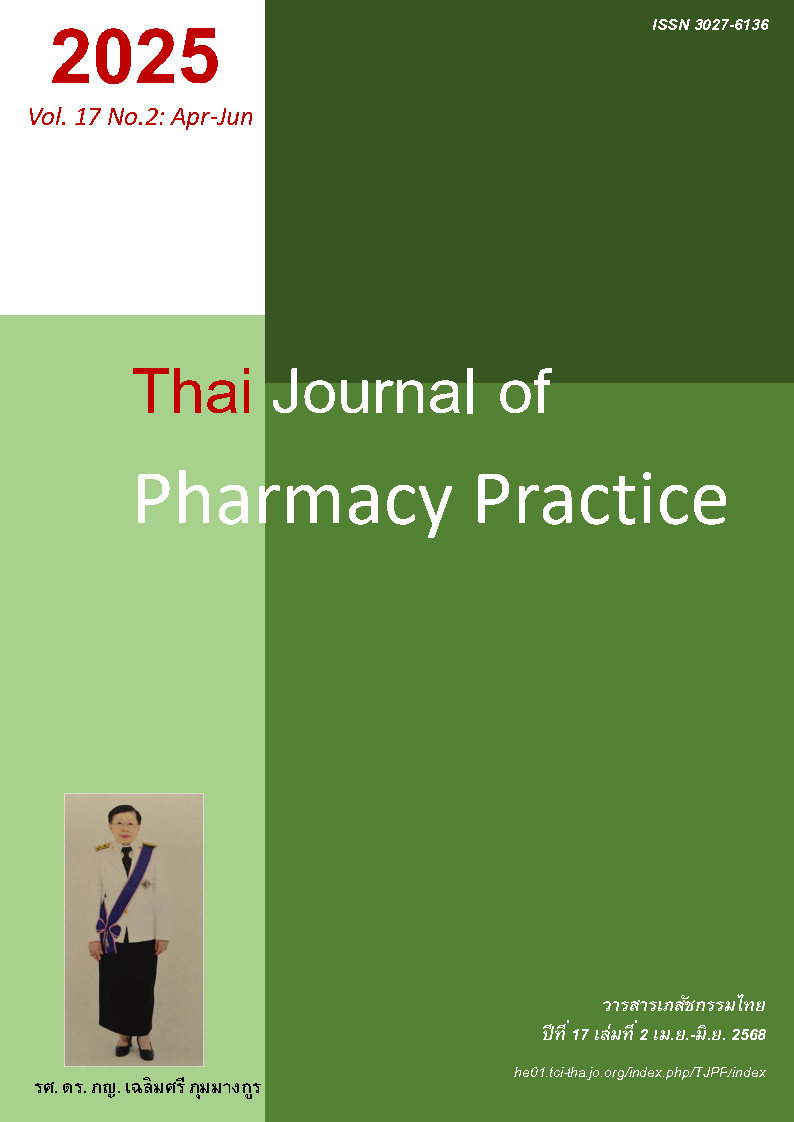ความชุกและปัจจัยที่มีความสัมพันธ์กับการที่พ่อแม่ปฏิเสธให้ลูกอายุ ตั้งแต่ 5 ถึงน้อยกว่า 18 ปีฉีดวัคซีนป้องกันโรคโควิด-19 ในจังหวัดนนทบุรี
Main Article Content
บทคัดย่อ
วัตถุประสงค์: เพื่อระบุความชุกและศึกษาปัจจัยที่มีความสัมพันธ์กับการที่พ่อแม่ปฏิเสธให้ลูกฉีดวัคซีนป้องกัน
โรคโควิด-19 วิธีการ: งานวิจัยนี้เป็นการศึกษาเชิงพรรณนาแบบภาคตัดขวาง เก็บข้อมูลตั้งแต่วันที่ 1 ตุลาคม ถึง 31 ธันวาคม พ.ศ.2565 กลุ่มตัวอย่างคือพ่อแม่ผู้ให้กำเนิดลูกที่มีอายุตั้งแต่ 5 ถึงน้อยกว่า 18 ปี จำนวน 440 คน ในชุมชนซึ่งอยู่ในพื้นที่รับผิดชอบของโรงพยาบาลส่งเสริมสุขภาพตำบลที่ตั้งอยู่ในพื้นที่จังหวัดนนทบุรี จำนวน 12 แห่ง โดยมีอาสาสมัครสาธารณสุขประจำหมู่บ้านเป็นผู้เก็บข้อมูลโดยใช้แบบสอบถามชนิดที่กลุ่มตัวอย่างสามารถเลือกตอบได้ด้วยตนเอง ผลการวิจัย: ผู้เข้าร่วมงานวิจัยส่วนใหญ่เป็นแม่ (ร้อยละ 65.9) ความชุกที่พ่อแม่ปฏิเสธให้ลูกฉีดวัคซีนป้องกันโรคโควิด-19 คิดเป็นร้อยละ 24.5 การศึกษาพบ 5 ปัจจัยที่มีความสัมพันธ์กับการที่พ่อแม่ปฏิเสธให้ลูกฉีดวัคซีน ได้แก่ 1) ผู้ตัดสินใจในเรื่องการฉีดวัคซีน โดยแม่ปฏิเสธให้ลูกฉีดวัคซีนมากกว่าพ่อ (adjusted OR = 1.87; 95% CI: 1.07-3.29; P=0.029) 2) ระดับการศึกษา โดยพ่อแม่ที่มีระดับการศึกษาต่ำกว่าปริญญาตรีปฏิเสธให้ลูกฉีดวัคซีนมากกว่าพ่อแม่ที่มีระดับการศึกษาตั้งแต่ปริญญาตรีขึ้นไป (adjusted OR = 8.8; 95% CI: 3.77-20.53; P<0.001) 3) ประวัติการได้รับวัคซีนของพ่อแม่ โดยพ่อแม่ที่ไม่เคยได้รับวัคซีนปฏิเสธให้ลูกฉีดวัคซีนมากกว่าพ่อแม่ที่เคยได้รับวัคซีน (adjusted OR = 2.93; 95% CI: 1.51-5.72; P=0.002) 4) การตระหนักถึงความเสี่ยงที่ลูก
จะติดเชื้อเมื่อลูกไปโรงเรียน โดยพ่อแม่ที่ไม่ตระหนักถึงความเสี่ยงที่ลูกจะติดเชื้อเมื่อลูกไปโรงเรียนปฏิเสธให้ลูกฉีดวัคซีนมากกว่าพ่อแม่ที่ตระหนักถึงความเสี่ยง (adjusted OR = 4.08; 95% CI: 2.31-7.21; P<0.001) และ 5) ความประสงค์ของลูกที่จะฉีดวัคซีน
โดยพ่อแม่ที่ลูกไม่ประสงค์จะฉีดวัคซีนปฏิเสธให้ลูกฉีดวัคซีนมากกว่าพ่อแม่ที่ลูกประสงค์จะฉีด (adjusted OR = 5.53; 95% CI: 3.21-9.52; P<0.001) สรุป: ปัจจัยที่มีความสัมพันธ์กับการที่พ่อแม่ปฏิเสธให้ลูกฉีดวัคซีนป้องกันโรคโควิด-19 อาจเป็นอุปสรรคต่อแผนการเสริมสร้างภูมิคุ้มกันหมู่ในเด็ก ผู้มีส่วนเกี่ยวข้องควรหาแนวทางในการลดปัจจัยที่อาจเป็นอุปสรรคเหล่านั้นเพื่อให้พ่อแม่ยินยอมให้ลูกฉีดวัคซีนเพิ่มขึ้นจนเกิดภูมิคุ้มกันหมู่ในเด็กต่อโรคโควิด-19
Article Details

This work is licensed under a Creative Commons Attribution-NonCommercial-NoDerivatives 4.0 International License.
ผลการวิจัยและความคิดเห็นที่ปรากฏในบทความถือเป็นความคิดเห็นและอยู่ในความรับผิดชอบของผู้นิพนธ์ มิใช่ความเห็นหรือความรับผิดชอบของกองบรรณาธิการ หรือคณะเภสัชศาสตร์ มหาวิทยาลัยสงขลานครินทร์ ทั้งนี้ไม่รวมความผิดพลาดอันเกิดจากการพิมพ์ บทความที่ได้รับการเผยแพร่โดยวารสารเภสัชกรรมไทยถือเป็นสิทธิ์ของวารสารฯ
References
Singla R, Mishra A, Joshi R, Jha S, Sharma R, Upadhyay S, et al. Human animal interface of SARS-CoV-2 (COVID-19) transmission: a critical appraisal of scientific evidence. Vet Res Commun 2020; 44: 119-30.
World Health Organization. WHO Coronavirus (COVID-19) dashboard [online]. 2022 [cited Jun 18, 2022]. Available from: covid19.who.int
The Royal College Pediatricians of Thailand. Covid-19 situation among children (aged 0-18 years) in Thailand from April 1, 2021 - December 29, 2021 (Weeks 15-53) [online]. 2022 [cited Jun 30, 2022]. Available from: www.thaipediatrics.org/?p=2539
The Royal College Pediatricians of Thailand. COVID-19 Interim guidance management of children with COVID-19 (Issue 1/2022) [online]. 2022 [cited Jun 29, 2022]. Available from: www. thaipediatrics.org /?p=1222
Amin UA, Parveen AP. Impact of COVID-19 on children. Middle East Curr Psychiatry. 2022; 29: 94. doi.org/10.1186/s43045-022-00256-3
Feldstein LR, Tenforde MW, Friedman KG, Newham M, Rose EB, Dapul H, et al. Characteristics and outcomes of US children and adolescents with multisystem inflammatory syndrome in children (MIS-C) compared with severe acute COVID-19. JAMA. 2021; 325: 1074-87.
The Royal College Pediatricians of Thailand. Recom mendations for vaccination against COVID-19 for children and adolescents (Issue 4) [online]. 2022 [cited Jul 2, 2022]. Available from: www.thaipedia trics.org/?p=1015
Ashby B, Best A. Herd immunity. Curr Biol 2021; 31: R174-R177.
World Health Organization. Coronavirus disease (COVID-19) questions and answers on Herd immunity, lockdowns and COVID-19 [online]. 2020 [cited May 3, 2022]. Available from: www.who.int/thai land/emergencies/novel-coronavirus-2019/q-a-on-co vid-19/q-a-on-covid-19-herd-immunity-lockdowns-an d-covid-19
Archananupap S. Herd immunity. Morchawban 2021; 507: 19-20.
The Bureau of Registration Administration. Official statistics registration systems [online]. 2022 [cited May 3, 2022]. Available from: stat.bora.dopa.go.th/ stat/statnew/statMONTH/statmonth/#/displayData
Nonthaburi Provincial Public Health Office. Sum- mary of COVID-19 vaccinations Nonthaburi province as of June 17, 2022 [online]. 2022 [cited June 18, 2022]. Available from: m.facebook.com/story.php? story_fbid=pfbid0bYaqHyqzprGhUEcYu5GYT1ztTHCp3Upsw9LKJ9bTRPR81gr9mqJqWx2LfL5SBeykl&id=723209481&mibextid=Nif5oz
Al-Metwali BZ, Al-Jumaili AA, Al-Alag ZA, Sorof- man B. Exploring the acceptance of COVID-19 vaccine among healthcare workers and general population using health belief model. J Eval Clin Pract 2021; 27: 1112-22.
Panchalingam T, Shi Y. Parental refusal and hesitancy of vaccinating children against COVID-19: findings from a nationally representative sample of parents in the U.S. Prev Med. 2022; 164: 107288. doi: 10.1016/j.ypmed.2022.107288.
Maneesriwongul W, Butsing N, Deesamer S. Parental hesitancy on COVID-19 vaccination for children under five years in Thailand: role of attitudes and vaccine literacy. Patient Prefer Adherence 2023; 17: 615-28.
Dhand NK, Khatkar MS. Statulator: An online statistical calculator: sample size calculator for estimating a single proportion [online]. 2014 [cited Apr 27, 2022]. Available from: statulator.com/Sample Size/ ss1P.html.
Health Serve. List of subdistrict health promoting hospitals in Nonthaburi Province [online]. 2023 [cited Nov 15, 2023]. Available from: healthserv.net/hospi talnews/1894
Yadav AK, Kumar S, Singh G, Kansara NK. Demysti fying r naught: understanding what does it hide?
Indian J Community Med 2021; 46: 7-14.
Minkin R, Horowitz J. Mental health concerns top the list of worries for parents; most say being a parent is harder than they expected [online]. 2023 [cited Oct 4, 2022]. Available from: www.pewre search.org/social-trends/2023/01/24/parenting-in-am erica-today/
Almalki OS, Alfayez OM, Yami M, Asiri YA, Almo hammed OA. Parents' hesitancy to vaccinate their 5-11 years old children against COVID-19 in Saudi Arabia: predictors from the health belief model. Front Public Health. 2022; 10: 842-62.
Voo JYH, Lean QY, Ming LC, Md Hanafiah NH, Al-Worafi YM, Ibrahim B. Vaccine knowledge, aware- ness and hesitancy: a cross sectional survey among parents residing at Sandakan District, Sabah. Vaccines (Basel) 2021; 9: 1348. doi:10.3390/vaccine s9111348.
Lertpakornteeratat P. Attitudes of employees toward working with different age groups of worker population in Bangkok metropolis [online]. 2019 [cited Oct 1, 2023]. Available from: mmm.ru.ac.th/ MMM/IS/twin-7/6114152039.pdf

